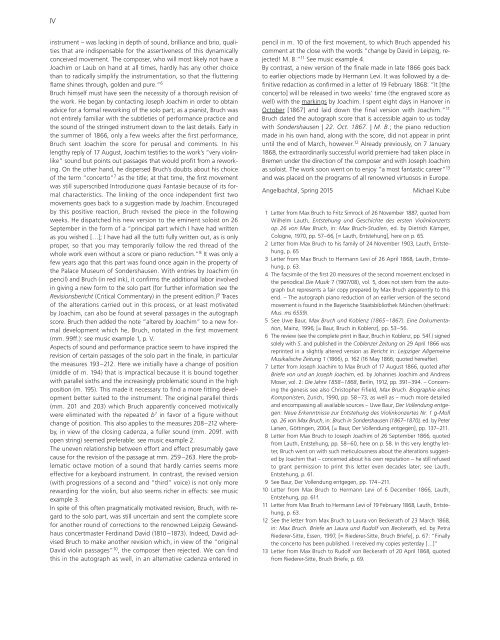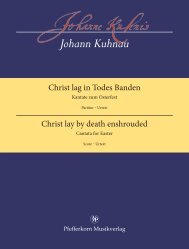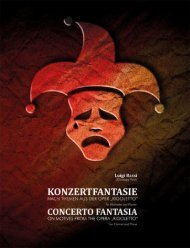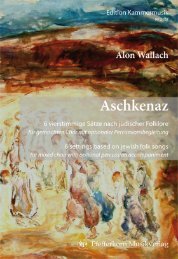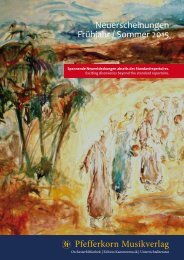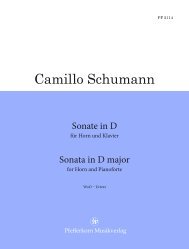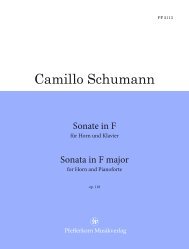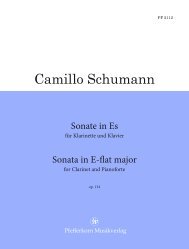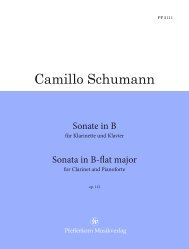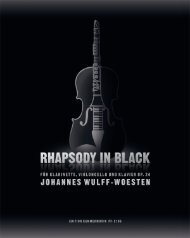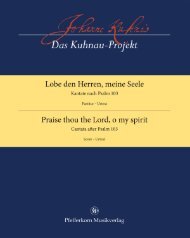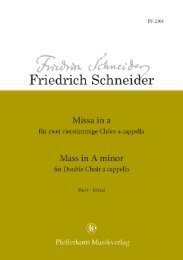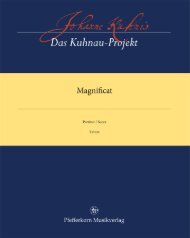Max Bruch - Violinkonzert Nr. 1 g-moll op. 26
Bruch, Violinkonzert, Breitkopf, Partitur-Bibliothek
Bruch, Violinkonzert, Breitkopf, Partitur-Bibliothek
Sie wollen auch ein ePaper? Erhöhen Sie die Reichweite Ihrer Titel.
YUMPU macht aus Druck-PDFs automatisch weboptimierte ePaper, die Google liebt.
IV<br />
instrument – was lacking in depth of sound, brilliance and brio, qualities<br />
that are indispensable for the assertiveness of this dynamically<br />
conceived movement. The composer, who will most likely not have a<br />
Joachim or Laub on hand at all times, hardly has any other choice<br />
than to radically simplify the instrumentation, so that the fluttering<br />
flame shines through, golden and pure.” 6<br />
<strong>Bruch</strong> himself must have seen the necessity of a thorough revision of<br />
the work. He began by contacting Joseph Joachim in order to obtain<br />
advice for a formal reworking of the solo part; as a pianist, <strong>Bruch</strong> was<br />
not entirely familiar with the subtleties of performance practice and<br />
the sound of the stringed instrument down to the last details. Early in<br />
the summer of 1866, only a few weeks after the first performance,<br />
<strong>Bruch</strong> sent Joachim the score for perusal and comments. In his<br />
lengthy reply of 17 August, Joachim testifies to the work’s “very violinlike”<br />
sound but points out passages that would profit from a reworking.<br />
On the other hand, he dispersed <strong>Bruch</strong>’s doubts about his choice<br />
of the term “concerto” 7 as the title; at that time, the first movement<br />
was still superscribed Introduzione quasi Fantasie because of its formal<br />
characteristics. The linking of the once independent first two<br />
movements goes back to a suggestion made by Joachim. Encouraged<br />
by this positive reaction, <strong>Bruch</strong> revised the piece in the following<br />
weeks. He dispatched his new version to the eminent soloist on <strong>26</strong><br />
September in the form of a “principal part which I have had written<br />
as you wished […]; I have had all the tutti fully written out, as is only<br />
pr<strong>op</strong>er, so that you may temporarily follow the red thread of the<br />
whole work even without a score or piano reduction.” 8 It was only a<br />
few years ago that this part was found once again in the pr<strong>op</strong>erty of<br />
the Palace Museum of Sondershausen. With entries by Joachim (in<br />
pencil) and <strong>Bruch</strong> (in red ink), it confirms the additional labor involved<br />
in giving a new form to the solo part (for further information see the<br />
Revisionsbericht (Critical Commentary) in the present edition.) 9 Traces<br />
of the alterations carried out in this process, or at least motivated<br />
by Joachim, can also be found at several passages in the autograph<br />
score. <strong>Bruch</strong> then added the note “altered by Joachim” to a new formal<br />
devel<strong>op</strong>ment which he, <strong>Bruch</strong>, notated in the first movement<br />
(mm. 99ff.): see music example 1, p. V.<br />
Aspects of sound and performance practice seem to have inspired the<br />
revision of certain passages of the solo part in the finale, in particular<br />
the measures 193–212. Here we initially have a change of position<br />
(middle of m. 194) that is impractical because it is bound together<br />
with parallel sixths and the increasingly problematic sound in the high<br />
position (m. 195). This made it necessary to find a more fitting devel<strong>op</strong>ment<br />
better suited to the instrument. The original parallel thirds<br />
(mm. 201 and 203) which <strong>Bruch</strong> apparently conceived motivically<br />
were eliminated with the repeated b 1 in favor of a figure without<br />
change of position. This also applies to the measures 208–212 whereby,<br />
in view of the closing cadenza, a fuller sound (mm. 209f. with<br />
<strong>op</strong>en string) seemed preferable: see music example 2.<br />
The uneven relationship between effort and effect presumably gave<br />
cause for the revision of the passage at mm. 259 –<strong>26</strong>3. Here the problematic<br />
octave motion of a sound that hardly carries seems more<br />
effective for a keyboard instrument. In contrast, the revised version<br />
(with progressions of a second and “third” voice) is not only more<br />
rewarding for the violin, but also seems richer in effects: see music<br />
example 3.<br />
In spite of this often pragmatically motivated revision, <strong>Bruch</strong>, with regard<br />
to the solo part, was still uncertain and sent the complete score<br />
for another round of corrections to the renowned Leipzig Gewandhaus<br />
concertmaster Ferdinand David (1810 –1873). Indeed, David advised<br />
<strong>Bruch</strong> to make another revision which, in view of the “original<br />
David violin passages” 10 , the composer then rejected. We can find<br />
this in the autograph as well, in an alternative cadenza entered in<br />
pencil in m. 10 of the first movement, to which <strong>Bruch</strong> appended his<br />
comment at the close with the words “change by David in Leipzig, rejected!<br />
M. B.” 11 See music example 4.<br />
By contrast, a new version of the finale made in late 1866 goes back<br />
to earlier objections made by Hermann Levi. It was followed by a definitive<br />
redaction as confirmed in a letter of 19 February 1868: “It [the<br />
concerto] will be released in two weeks’ time (the engraved score as<br />
well) with the markings by Joachim. I spent eight days in Hanover in<br />
October [1867] and laid down the final version with Joachim.” 11<br />
<strong>Bruch</strong> dated the autograph score that is accessible again to us today<br />
with Sondershausen | 22. Oct. 1867. | M. B.; the piano reduction<br />
made in his own hand, along with the score, did not appear in print<br />
until the end of March, however. 12 Already previously, on 7 January<br />
1868, the extraordinarily successful world premiere had taken place in<br />
Bremen under the direction of the composer and with Joseph Joachim<br />
as soloist. The work soon went on to enjoy “a most fantastic career” 13<br />
and was placed on the programs of all renowned virtuosos in Eur<strong>op</strong>e.<br />
Angelbachtal, Spring 2015<br />
Michael Kube<br />
1 Letter from <strong>Max</strong> <strong>Bruch</strong> to Fritz Simrock of <strong>26</strong> November 1887, quoted from<br />
Wilhelm Lauth, Entstehung und Geschichte des ersten <strong>Violinkonzert</strong>s<br />
<strong>op</strong>. <strong>26</strong> von <strong>Max</strong> <strong>Bruch</strong>, in: <strong>Max</strong> <strong>Bruch</strong>-Studien, ed. by Dietrich Kämper,<br />
Cologne, 1970, pp. 57–66, [= Lauth, Entstehung], here on p. 65.<br />
2 Letter from <strong>Max</strong> <strong>Bruch</strong> to his family of 24 November 1903, Lauth, Entstehung,<br />
p. 65<br />
3 Letter from <strong>Max</strong> <strong>Bruch</strong> to Hermann Levi of <strong>26</strong> April 1868, Lauth, Entstehung,<br />
p. 63.<br />
4 The facsimile of the first 20 measures of the second movement enclosed in<br />
the periodical Die Musik 7 (1907/08), vol. 5, does not stem from the autograph<br />
but represents a fair c<strong>op</strong>y prepared by <strong>Max</strong> <strong>Bruch</strong> apparently to this<br />
end. – The autograph piano reduction of an earlier version of the second<br />
movement is found in the Bayerische Staatsbibliothek München (shelfmark:<br />
Mus. ms 6559).<br />
5 See Uwe Baur, <strong>Max</strong> <strong>Bruch</strong> und Koblenz (1865–1867). Eine Dokumentation,<br />
Mainz, 1996, [= Baur, <strong>Bruch</strong> in Koblenz], pp. 53–56.<br />
6 The review (see the complete print in Baur, <strong>Bruch</strong> in Koblenz, pp. 54f.) signed<br />
solely with S. and published in the Coblenzer Zeitung on 29 April 1866 was<br />
reprinted in a slightly altered version as Bericht in: Leipziger Allgemeine<br />
Musikalische Zeitung 1 (1866), p. 162 (16 May 1866; quoted hereafter).<br />
7 Letter from Joseph Joachim to <strong>Max</strong> <strong>Bruch</strong> of 17 August 1866, quoted after<br />
Briefe von und an Joseph Joachim, ed. by Johannes Joachim and Andreas<br />
Moser, vol. 2: Die Jahre 1858–1868, Berlin, 1912, pp. 391–394. – Concerning<br />
the genesis see also Christ<strong>op</strong>her Fifield, <strong>Max</strong> <strong>Bruch</strong>. Biographie eines<br />
Komponisten, Zurich, 1990, pp. 58 –73, as well as – much more detailed<br />
and encompassing all available sources – Uwe Baur, Der Vollendung entgegen:<br />
Neue Erkenntnisse zur Entstehung des <strong>Violinkonzert</strong>es <strong>Nr</strong>. 1 g-Moll<br />
<strong>op</strong>. <strong>26</strong> von <strong>Max</strong> <strong>Bruch</strong>, in: <strong>Bruch</strong> in Sondershausen (1867–1870), ed. by Peter<br />
Larsen, Göttingen, 2004, [= Baur, Der Vollendung entgegen], pp. 137–211.<br />
8 Letter from <strong>Max</strong> <strong>Bruch</strong> to Joseph Joachim of <strong>26</strong> September 1866, quoted<br />
from Lauth, Entstehung, pp. 58–60, here on p. 58. In this very lengthy letter,<br />
<strong>Bruch</strong> went on with such meticulousness about the alterations suggested<br />
by Joachim that – concerned about his own reputation – he still refused<br />
to grant permission to print this letter even decades later; see Lauth,<br />
Entstehung, p. 61.<br />
9 See Baur, Der Vollendung entgegen, pp. 174 –211.<br />
10 Letter from <strong>Max</strong> <strong>Bruch</strong> to Hermann Levi of 6 December 1866, Lauth,<br />
Entstehung, pp. 61f.<br />
11 Letter from <strong>Max</strong> <strong>Bruch</strong> to Hermann Levi of 19 February 1868, Lauth, Entstehung,<br />
p. 63.<br />
12 See the letter from <strong>Max</strong> <strong>Bruch</strong> to Laura von Beckerath of 23 March 1868,<br />
in: <strong>Max</strong> <strong>Bruch</strong>. Briefe an Laura und Rudolf von Beckerath, ed. by Petra<br />
Riederer-Sitte, Essen, 1997, [= Riederer-Sitte, <strong>Bruch</strong> Briefe], p. 67: “Finally<br />
the concerto has been published. I received my c<strong>op</strong>ies yesterday […]”<br />
13 Letter from <strong>Max</strong> <strong>Bruch</strong> to Rudolf von Beckerath of 20 April 1868, quoted<br />
from Riederer-Sitte, <strong>Bruch</strong> Briefe, p. 69.


